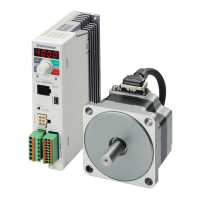5
Installing a load of the combination type parallel
gearhead or round shaft type
When installing a load on the motor or the gearhead, align the center of the
motor output shaft or the gearhead output shaft with the center of the load
shaft.
Note
When coupling the motor or the gearhead with a load, pay
attention to centering, belt tension, parallelism of pulleys,
etc. Also, rmly secure the tightening screws of the
coupling or pulleys.
When installing a load, do not damage the motor output
shaft (gearhead output shaft) or bearing. Forcing in the
load by driving it with a hammer, etc., may break the
bearing. Do not apply any excessive force to the output
shaft.
Do not modify or machine the output shaft of the motor or
gearhead. Doing so may damage the bearings, leading to
damage to the motor or gearhead.
z
Output shaft shape
Combination type parallel shaft gearhead
A key groove is provided on the output shaft of each combination type
parallel shaft gearhead. Form a key groove on the load side and ax the load
using the included parallel key. [Parallel key dimension: 6 mm (0.236 in.)]
Round shaft type
A at section is provided on the motor output shaft of each round shaft type.
Apply a double-point screw, etc., at the at section to securely ax the load
and prevent it from spinning.
z
How to install a load
Using a coupling
Align the centerline of the motor or gearhead output shaft with the centerline
of the load shaft.
Using a belt
Adjust the motor or gearhead output shaft to lie parallel with the load shaft,
and form right angles between the output shaft/load shaft and the line
connecting the centers of both pulleys.
Using a gear
Adjust the motor or gearhead output shaft to lie parallel with the gear shaft,
and allow the output shaft to mesh correctly with the centers of the gear teeth.
When using the output axis tip screw
hole of a gearhead
Use a screw hole [M6; Eective depth
12 mm (0.47 in)] provided at the tip of
the output shaft as an auxiliary means
for preventing the transfer mechanism
from disengaging.
Screw
Spacer
parts
Installing a load of the combination type hollow shaft
at gearhead
If the motor is subject to a strong impact upon instantaneous stop or receives
a large radial load, use a stepped load shaft.
Note
Apply grease (molybdenum disulde grease, etc.) on the
surface of the load shaft and inner walls of the hollow output
shaft to prevent seizure.
z
Recommended load shaft installation dimensions
[Unit: mm (in.)]
Inner diameter of
hollow shaft (H8)
Recommended diameter
of load shaft (h7)
Nominal diameter of
retaining ring
Ø25
(0.9843
)
Ø25
(0.9843
)
Ø25 (0.98)
Applicable screw Spacer thickness
Outer diameter of stepped
shaft (ØD)
M8
6 (0.24)
[3 (0.12)]
40 (1.57)
The value in [ ] is the thickness when installing the gearhead by using its
rear side as the mounting surface.
z
Stepped load shaft
Install each hexagonal socket head screw over a retaining ring, spacer, at
washer and spring washer and securely ax the ring.
Flat washer
Spacer
Retaining ring
Stepped
load shaft
Spring washer
Hexagonal socket
head screw
Retaining ring
Hollow output shaft
head screw
Spring washer
Flat washer
Spacer
Parallel key
Load shaft
ØD
z
Non-stepped load shaft
Install each hexagonal socket head screw over a retaining ring, spacer, at
washer and spring washer and securely ax the ring. Also insert a spacer on
the load shaft side.
Flat washer
Spacer
Retaining ring
Load shaft
Spring washer
Hexagonal socket
head screw
Spacer
Retaining ring
Hollow output shaft
head screw
Spring washer
Flat washer
Parallel key
Load shaft
Permissible radial load and permissible axial load
Note
Failure due to fatigue may occur when the motor or gearhead
bearings and output shaft are subject to repeated loading by
a radial or axial load that is in excess of the permissible limit.
z
Combination type parallel shaft gearhead
Gear ratio
Distance from tip of gearhead output
shaft and permissible radial load
[N (lb.)]
Permissible
axial load
[N (lb.)]
10 mm (0.39 in.) 20 mm (0.79 in.)
5 to 20
550 (123)
<500 (112)>
800 (180)
<700 (157)>
200 (45)
30, 50
1000 (220)
<900 (200)>
1250 (280)
<1100 (240)>
300 (67)
100, 200
1400 (310)
<1200 (270)>
1700 (380)
<1400 (310)>
400 (90)
The values assume a rated speed of 3000 r/min or below.
The values in < > are based on a rated speed of 4000 r/min.

